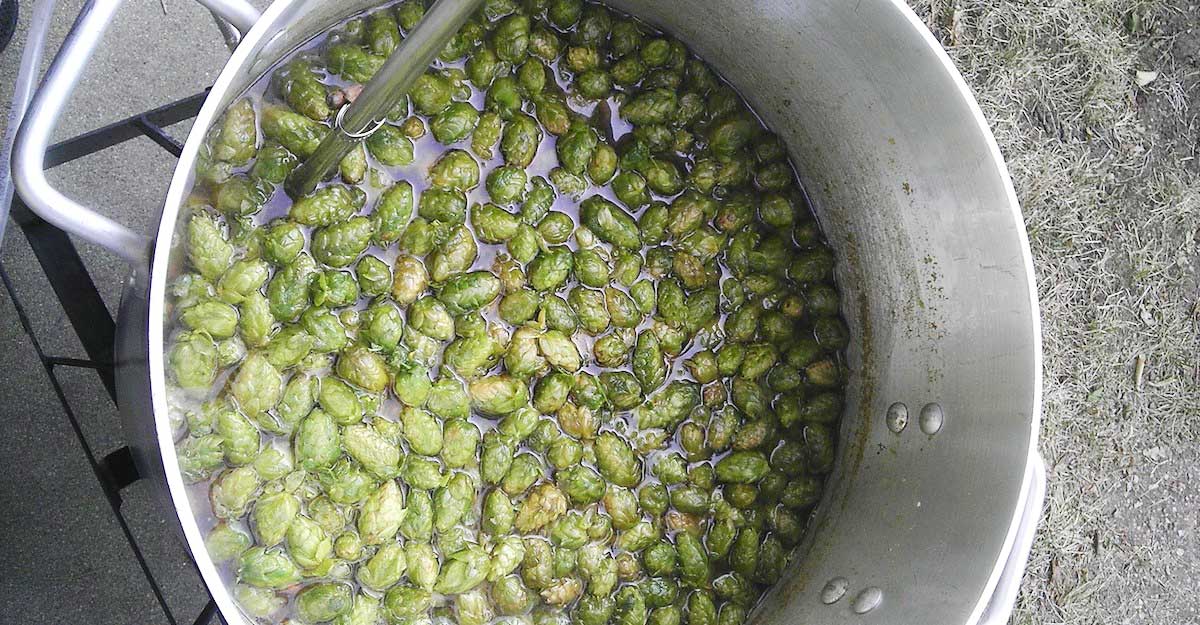Many things in this life bring me joy, but I do not count small talk among them. While I recognize that plenty of otherwise sane people enjoy the phatic speech that accompanies meet-and-greets, supermarket checkout lines, and sharing the same row in coach, these situations just make me tired. I will say, though, that small talk of the inter-human variety has become considerably easier since I started making my own beer. Almost everyone likes to talk about beer, even introverts and curmudgeons. And, when the topic arises, one of the most common questions is perhaps to be expected: “Is brewing difficult?”
There’s a lot of walking to and fro, I tell them, and you have to heave the occasional sack of grain. Sometimes there’s math. But generally, brewing is pretty simple. And backyard brewers, in particular, enjoy a huge advantage over the pros: You can afford to mess around with only minor consequences for messing up.
Take fresh hops. Hauling in the harvest on a hops farm and getting those freshies to your production brewery is hard work that requires machinery, light aircraft, and plenty of manual labor. You need a solid, predictable recipe in place for your one chance to get it right, or you’ll have to wait until next year to try again.
But making a fresh-hops beer at home doesn’t necessarily require that much forethought. Such was the case a couple of weeks ago when a good friend asked if I wanted any of his ripe Cascades. I was working to meet a number of deadlines and didn’t exactly have time to brew, but the hops were ready, whether or not I was. Reasoning that I could always type during the mash and the boil, I headed over with a canvas bag, picked a pound and a half of fresh, green cones, and made up a recipe using ingredients I already had on hand.
Below is what I conjured up. It features Amarillo first wort hops for bitterness and flavor, some late kettle Cascade pellets, and 21 ounces (595 grams) of fresh Cascade cones. This rye IPA features a 20-minute hop stand, which is nothing more than leaving the hops in hot wort for an extended period of time after the boil. Professionals would rely on a whirlpool or hopback to achieve similar ends, but if you lack such equipment, a hop stand is the next best thing.

This is an experimental recipe, for sure, but it’s hard to screw up too badly with so many just-picked cones. If you don’t already have your own fresh hops recipe, give this one a try. Just remember that when it comes to wet-hopped beers like this one, hops freshness is far more important than hops variety. Cheers!
Idle Chatter Rye IPA
ALL-GRAIN
Boil size: 6.50 gal (24.6 l)
Batch size (into fermentor): 5.25 gal (19.9 l)
Final volume (at packaging): 5 gal (19 l)
Brewhouse efficiency: 72%
OG: 1.064
FG: 1.012
IBUs: 72
ABV: 6.8%
MALT/GRAIN BILL
10 lb (4.5 kg) Pale malt
2 lb (907 g) Rye malt
8 oz (227 g) Caramel 10 malt
8 oz (227 g) Flaked rye
4 oz (113 g) Simpsons Medium Crystal malt
HOPS SCHEDULE
Kettle Hops
1.25 oz (35 g) Amarillo pellets (10% AA) at first wort hop
1 oz (28 g) Cascade pellets (6% AA) at 15 minutes
Hop Stand Hops
21 oz (595 g) Fresh (wet) Cascade cones for 20-minute hop stand
0.5 oz (14 g) Amarillo pellets for 20-minute hop stand
DIRECTIONS
Mash grain at 152°F (67°C) for 60 minutes. Add first wort hops to the kettle as soon as you begin collecting the first runnings. Lauter and sparge to a pre-boil volume of 6.5 gallons (24.6 liters) and boil for 60 minutes, following the kettle hops schedule. Add the hop stand additions at knockout, and allow them to steep in the hot wort for 20 minutes before chilling (whirlpool or use a hopback if your system allows it). Cool to 64°F (18°C), pitch yeast, and ferment until the specific gravity stabilizes. Rack to secondary if desired (consider “dry hopping” with more fresh hops if you have them!), then bottle or keg to 2.6 volumes of CO2.
YEAST OPTIONS
Wyeast 1056 American Ale
White Labs WLP001 California Ale
Safale US-05

